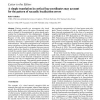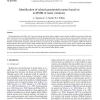2347 search results - page 297 / 470 » Location, location, location: a study of bluejacking practic... |
TSP
2008
13 years 8 months ago
2008
We study the problem of tracking an object that is moving randomly through a dense network of wireless sensors. We assume that each sensor has a limited range for detecting the pr...
JSW
2007
13 years 8 months ago
2007
— Social network analysis has been used for quite some time to analyze and understand the behavior of nodes in the network. Theses nodes could be individuals or group of persons,...
BC
2004
13 years 8 months ago
2004
During saccadic eye movements, the visual world shifts rapidly across the retina. Perceptual continuity is thought to be maintained by active neural mechanisms that compensate for ...
CANDC
2004
ACM
13 years 8 months ago
2004
ACM
Gene and protein names follow few, if any, true naming conventions and are subject to great variation in different occurrences of the same name. This gives rise to two important p...
CORR
2004
Springer
13 years 8 months ago
2004
Springer
An optimization problem that naturally arises in the study of swarm robotics is the Freeze-Tag Problem (FTP) of how to awaken a set of "asleep" robots, by having an awak...


